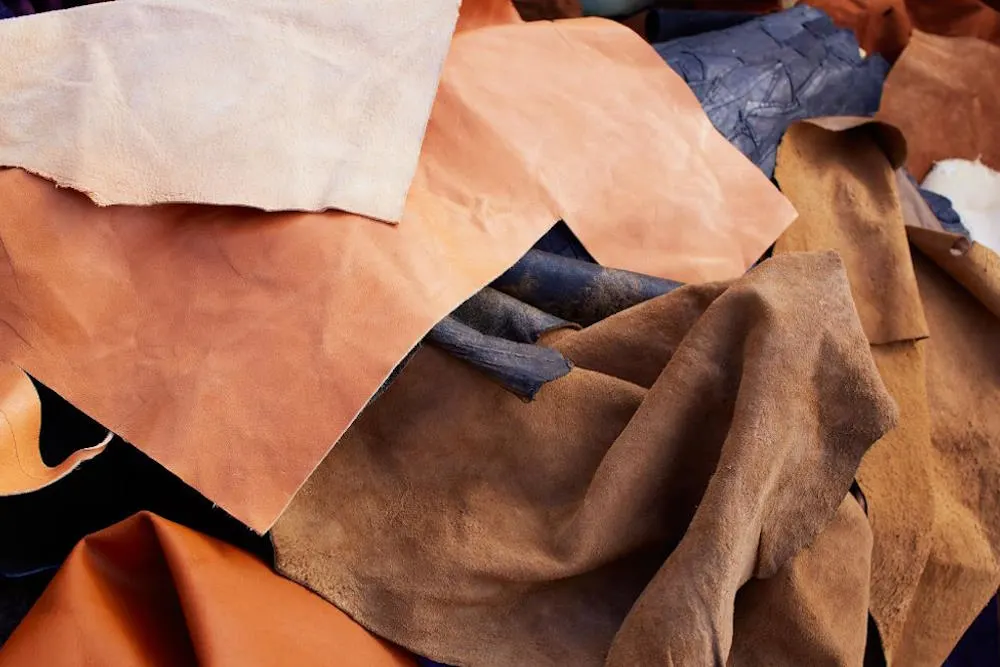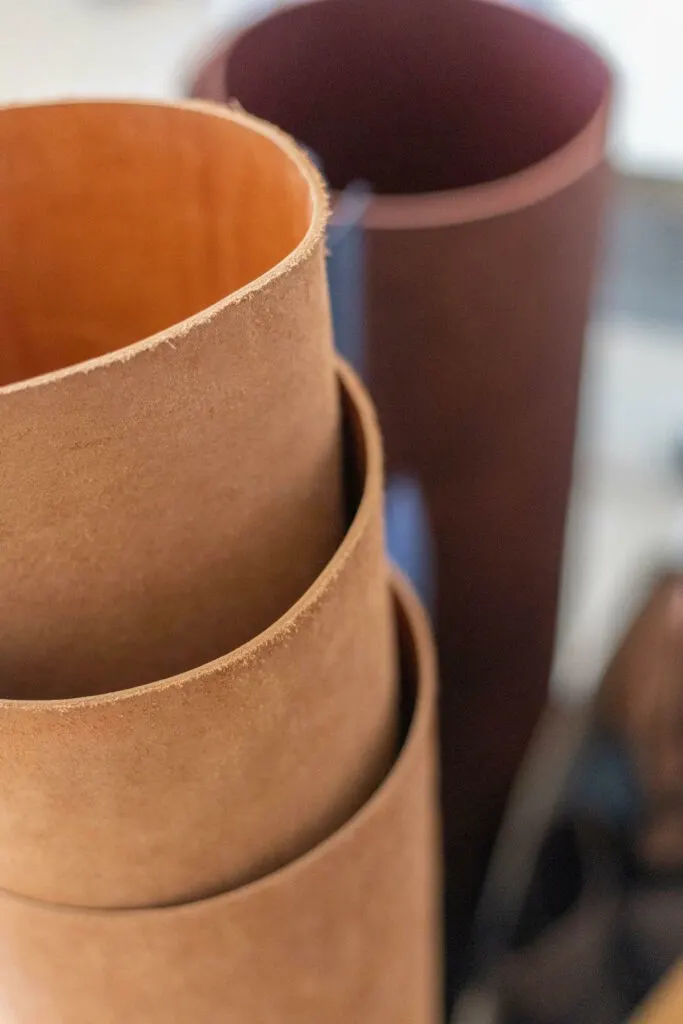Leather tanning is a crucial process in transforming animal hides into durable, versatile, and fashionable materials for various products like clothing, accessories, and furniture.

This age-old craft, which dates back thousands of years, involves altering the protein structure of the skin to make it resistant to decay and suitable for a range of applications. If you are considering a career as a leather tanner, it’s essential to understand the steps involved in the process and the skills required to succeed in this industry.
The journey to becoming a leather tanner begins with gaining an understanding of the different types of tanning methods, such as vegetable tanning, chrome tanning, and aldehyde tanning. Each method has its unique characteristics and uses, so having a thorough knowledge of these techniques can provide a solid foundation for your career. Additionally, it’s important to learn about the various pre-tanning stages, including dehairing, degreasing, and soaking the hides, as well as post-tanning procedures like dyeing and finishing.
Besides acquiring technical knowledge, aspiring leather tanners should focus on developing essential skills like attention to detail, problem-solving, and collaboration. Working in a tannery often involves coordinating with other professionals, like designers and manufacturers, to meet specific product requirements and maintain quality standards. By honing these skills and acquiring hands-on experience in the field, you will be well on your way toward a rewarding career in the world of leather tanning.

History of Leather Tanning
Leather tanning has a rich history dating back to the Paleolithic period, about 40,000 years ago. Early humans began making moccasin-like footwear out of softened animal skins, or rawhide, which significantly improved their ability to travel long distances. This marked the beginning of leather-making.
The ancient civilization of Mehrgarh contributed significantly to the development of the leather tanning process. About 5,000 years ago, people in Egypt and Mesopotamia, particularly the Sumerians, started using plant-based tanning methods. They used the bark of the Acacia nilotica, or the gum arabic tree, which contains natural tannins. This plant-based tanning method was a slow but essential process in enhancing the durability of leather.
As the tanning process evolved over time, leatherworkers learned to use alkaline lime mixtures to prepare hides for tanning. By soaking the hides in these mixtures, it became easier to remove the hair and excess flesh from the animal skins. This crucial step in the tanning process allowed for better absorption of the tannins and improved the overall quality of the leather produced.
The tanning pit played a central role in the tanning process, as it was where the treated hides were submerged in a solution containing water and tannins. The pit’s depth varied depending on the size of the leather being produced. The leatherworkers would monitor and stir the hides periodically to ensure even distribution of the tanning solution. Once the tanning process was complete, the hides would be removed from the pit and further treated, depending on their intended use.
Throughout history, leather tanning has been an essential craft, supplying people with durable and versatile materials for various applications. From footwear to clothing and everyday items, the leather tanning process continues to be a vital industry that supports our modern needs.

Types of Leather Tanning
Leather tanning is the process of treating animal skins to transform them into durable, flexible, and usable leather products. There are various methods for tanning leather, each with its unique characteristics and techniques. In this section, we will discuss three primary types of leather tanning: Vegetable Tanning, Chrome Tanning, and Alternative Tanning Methods.
Vegetable Tanning
Vegetable tanning is one of the oldest and most traditional methods of leather tanning. It involves using natural tannins extracted from plant materials like tree bark, leaves, and fruits. These tannins, which are naturally occurring chemicals, act as tanning agents and help to create durable and unique leather products.
The vegetable tanning process is relatively slow, taking weeks or even months to complete. The leather produced by this method has a distinct appearance and feel, often retaining a more natural look and developing a beautiful patina over time.
Some advantages of vegetable tanning include:
- Environmentally friendly, using only natural materials
- Produces a high-quality leather with a unique look and feel
- Long-lasting and develops a rich patina with use
Chrome Tanning
Chrome tanning is a more modern and faster method of tanning leather. It involves using chromium salts, a type of chemical, as the primary tanning agent. The chrome tanning process is quicker than vegetable tanning, typically taking only a few days to complete.
The leather produced by this method is known for its softness, flexibility, and resistance to water and temperature changes. Chrome-tanned leather is widely used for various products such as footwear, upholstery, and fashion accessories.
Some benefits of chrome tanning include:
- Faster production time compared to vegetable tanning
- Produces soft, flexible, and water-resistant leather
- Often more affordable due to the quicker process
Alternative Tanning Methods
Besides vegetable and chrome tanning, there are also alternative tanning methods such as synthetic tanning, brain tanning, and oil tanning. These methods usually involve using different tanning agents and techniques to achieve unique leather qualities.
Synthetic tanning relies on synthetic chemicals to tan the leather, while brain tanning uses animal brains as the tanning agent. Oil tanning, as the name suggests, uses various oils, such as fish oil, egg yolk, and even yak butter, for a softer and more supple leather product.
While these alternative tanning methods might not be as popular as vegetable or chrome tanning, they offer additional options for producing distinctive leather goods with specific characteristics and properties.

Tanning Process Step by Step
Curing
Curing is the initial step in the leather tanning process. It involves treating raw hides or skins with salt to preserve them and remove any residual blood, dirt, and other contaminants. This prevents bacterial growth and decay, ensuring that the hide remains usable for further processing.
Beamhouse Operations
Beamhouse operations refer to a set of preparatory steps carried out before the actual tanning process. These operations include:
- Soaking: Hides are soaked in water to rehydrate them and remove any remaining salts, dirt, or other impurities from the curing process.
- Liming: In this step, hides are treated with a mixture of water and lime, which helps break down proteins and remove hair or fur. This process also helps to swell the collagen fibers in the hide, making it easier to work with during later stages.
- Unhairing: After liming, the loosened hair or fur is removed from the hide, either manually or using machines.
Deliming
Deliming is the process of neutralizing the alkaline residues from the previous liming step, by immersing the hides in a weak acidic solution. This step restores the collagen’s ability to absorb water and prepares the hide for further processing.
Bating
Bating is a fermentation process that softens the leather by breaking down any remaining proteins, fats, and other substances. This is achieved by treating the hides with enzymes, which help to remove unwanted materials and leave the collagen fibers intact.
Pickling
Pickling involves treating the hides with a mixture of water, salt, and a weak acidic solution (typically sulfuric acid or organic acids). This step lowers the pH of the hide and ensures that it is properly conditioned for the subsequent tanning stage.
Tanning Stage
The tanning stage is the core process that transforms the rawhide into leather, by chemically stabilizing the collagen fibers. There are various tanning methods available, such as vegetable tanning and chrome tanning. Each method has its own unique characteristics and is suitable for producing different types of leather. After the tanning stage, the hides are washed to remove excess chemicals and then dried before being subjected to further processing and finishing steps.

Becoming a Leather Tanner
Required Skills and Experience
To become a successful leather tanner, you should possess the following skills:
- Strong attention to detail
- Ability to handle raw hides and chemicals
- Proficiency in manual labor and craftsmanship
- Knowledge of different leather types and their applications
Experience in the leather industry, particularly in handling raw hides and working with various tanning processes, is also beneficial for aspiring leather tanners.
Training and Apprenticeship
Formal training is often not required to enter the leather tanning profession. However, you can benefit from honing your skills through workshops or online courses. The most effective way to learn and gain experience is by working as an apprentice under an experienced leather tanner or leather craftsmen. By apprenticing, you’ll be exposed to different techniques and methods used in the tanning process, as well as the production of various leather products such as footwear and accessories.
Working Conditions and Salary
The working conditions for a leather tanner often involve long hours of manual labor in a tannery. You may be exposed to chemicals, the smell of raw hides, and repetitive tasks. These conditions, along with the hands-on nature of the job, demand that tanners be physically fit and have a high level of stamina.
The salary for a leather tanner can vary based on experience and skill level. Entry-level positions may pay on an hourly basis, with opportunities for increased earnings as you gain more experience and become more proficient in the trade. While specific salary information may be hard to come by for this profession, compensation packages and benefits may be offered based on your level of skill and expertise in the field.
Leather Tanning Industry
The leather tanning industry plays a significant role in converting raw animal hides and skins into durable, useful materials. In this section, we’ll explore the tanning process, the types of facilities involved, and various leather products and their applications.
Tanneries and Factories
Tanneries are specialized facilities where the transformation of animal hides into leather occurs. These factories play a crucial role in the leather tanning process by permanently altering the protein structure of the skin, making it more durable, less susceptible to decomposition, and suitable for coloring and other treatments1. China dominates the modern leather tanning industry, with a 25% share of global production2.
In addition to tanneries, factories are responsible for further processing the tanned leather into finished products. This involves cutting, shaping, stitching, and adding hardware or embellishments as needed.
Leather Products and Applications
Leather finds its way into various applications due to its durability, versatility, and aesthetic appeal. Some common leather products include:
- Accessories: Leather is a popular choice for fashion accessories like belts and wallets, offering both functionality and style.
- Shoes: From casual sneakers to elegant dress shoes, leather footwear is highly sought after for its comfort, support, and timelessness.
- Clothing: Leather jackets, pants, and other garments make a statement with their unique texture and appearance.
- Furniture: Leather adds sophistication and luxury to home furnishings, such as sofas, armchairs, and ottomans.
- Full-grain leather products: Full-grain leather is the highest quality of leather, showcasing the natural grain of the hide. It is commonly used in high-end accessories, shoes, and furniture due to its strength and durability.
Environmental and Ethical Considerations
When looking at the process of becoming a leather tanner, it is essential to consider the environmental and ethical implications of the trade. Leather tanning requires the use of resources such as water, energy, and chemicals, which can have ecological consequences if not managed responsibly.
In the tanning process, one of the initial steps is to prevent putrefaction and preserve the animal skin. Traditionally, this is done using chemicals that can be harmful to the environment and affect the quality of water supplies. To minimize the negative impact, tanners can adopt alternative tanning methods such as vegetable tanning, which uses natural materials like tree bark extracts.
Moreover, sourcing raw materials for leather tanning is also an area where environmental and ethical concerns may arise. Leather is derived from animal hides, which are typically a by-product of the meat industry. It is crucial for tanners to source hides from suppliers that maintain high ethical standards in treating the animals, as this directly impacts the quality of the leather.
As leather tanning involves the use of heavy machinery for cutting, splitting, and dyeing, it is essential to ensure the machines are maintained and updated to minimize pollution and energy consumption. Newer, energy-efficient machinery can help reduce the environmental footprint of the tanning process.
Some factors to consider for a more environmentally friendly and ethical leather tanning process include:
- Using alternative tanning methods that are less resource-intensive and harmful.
- Sourcing hides from suppliers that adhere to best practices and providing a form of leather traceability.
- Implementing waste management systems in the facilities, such as recycling and proper disposal of chemicals.
- Complying with industry sustainability parameters, as outlined by organizations like the International Council for Tanners.
By taking these environmental and ethical considerations into account, aspiring leather tanners can contribute to a more sustainable industry while producing high-quality leather products.
